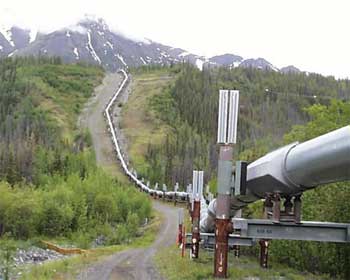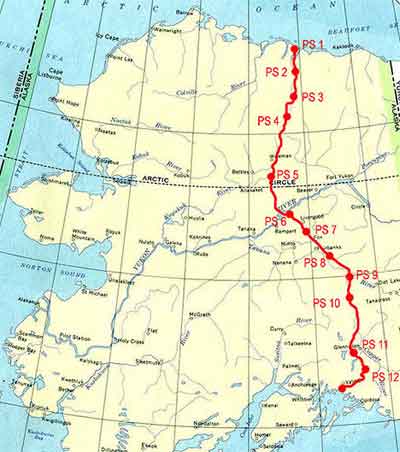redo Jump to...
print Print...
(by Mary Pemberton, KOMONews.com) ANCHORAGE, Alaska (AP) – The trans-Alaska pipeline remained shut down Sunday more than 24 hours after a leak was discovered at a North Slope pump station.
 Alyeska Pipeline Service Co. said the leak, which was discovered Saturday at 8:15 a.m., is coming from a section of below-ground piping encased in concrete next to Pump Station 1 – the first pump station on the 800-mile pipeline (see photo at right of an above-ground portion of the pipeline).
Alyeska Pipeline Service Co. said the leak, which was discovered Saturday at 8:15 a.m., is coming from a section of below-ground piping encased in concrete next to Pump Station 1 – the first pump station on the 800-mile pipeline (see photo at right of an above-ground portion of the pipeline).
The pump station at Prudhoe Bay takes in all the crude from North Slope oil fields before it is delivered to the main line and goes down the trans-Alaska pipeline to Valdez, where it is loaded onto tankers for delivery to the West Coast.
The pipeline, which normally carries between 630,000 and 650,000 barrels [a day], was shut down at 8:50 a.m. Alyeska Pipeline runs the pipeline for five companies that own it.
Alyeska Pipeline spokeswoman Michelle Egan said the leaked oil from the pipe went into the basement of the pump station. Work began Saturday afternoon and by noon Sunday about 90 percent had been removed. Some work remains, she said, for example cleaning up the walls. From nine to 10 barrels of oil was spilled, she said.
“We have the leak contained,” she said.
In the meantime, North Slope production has been cut to 5 percent of normal.
Tom DeRuyter, the on-scene coordinator for the Alaska Department of Environmental Conservation, said four responders were working on the spill.
The focus now is to get the pipeline operating again as quickly as possible, Egan said.
Alyeska Pipeline was looking at several scenarios, including bypassing the leak with temporary piping, Egan said. That’s because the area where the leak occurred is complex, and also is underground and encased in concrete and not easily accessible.
Egan did not know how quickly the pipeline could be put back into operation.
In the meantime, Alyeska Pipeline will be watching for any problems associated with low-flow in the pipeline, such as icing in the line. Ice in the line could interfere with machinery when the pipeline is returned to normal, causing another shutdown.
“We don’t like to shut down in winter unexpectedly,” Egan said. “We have to watch that very carefully.”
Associated Press. Reprinted here for educational purposes only. May not be reproduced on other websites without permission from KOMO News. Visit the website at komonews.com.
Questions
1. Answer the following questions about the trans-Alaska pipeline: (see article and “Background” below the questions for the answers)
a) How long is the pipeline?
b) When was the pipeline built?
c) Between what two places does the pipeline move oil?
d) How many barrels per day does the pipeline carry?
2. What does the Alyeska Pipeline Service Company do?
3. Why has the trans-Alaska pipeline been shut down for almost 3 days?
4. How much oil was spilled before the leak was contained?
5. To get the pipeline operating again, Alyeska Pipeline is considering bypassing the leak with temporary piping. Why are they considering this option?
6. Why doesn’t the Alyeska Pipeline Co. like to shut down the pipeline in the winter?
Background
TAPS: (from tapseis.anl.gov/guide/index.cfm)
- The Trans-Alaska Pipeline System (TAPS) is an 800-mile pipeline system that transports crude oil from Alaska’s North Slope to Port Valdez on Alaska’s Prince William Sound.
- Alyeska Pipeline Service Company operates TAPS, with regulatory oversight through the Joint Pipeline Office.
- (TAPS) consists of the pipeline, pump stations, a marine terminal, and associated facilities and systems.
- TAPS transports crude oil from Alaska’s North Slope to Port Valdez in Prince William Sound.
- TAPS is operated by Alyeska Pipeline Service Company on behalf of six owner companies.
- Federal and state governments cooperatively oversee the TAPS system and administer the federal and state rights-of-way terms and conditions through the Joint Pipeline Office (JPO).
Pipeline Quick Facts (from the Alyeska Pipeline Co. website. For more information, go to alyeska-pipe.com/pipelinefacts.html)
- The Trans Alaska Pipeline System was designed and constructed to move oil from the North Slope of Alaska to the northern most ice-free port in Valdez, Alaska.
- Length: 800 miles.
- Diameter: 48 inches.
- Crosses three mountain ranges and over 800 rivers and streams.
- Cost to build: $8 billion in 1977, largest privately funded construction project at that time.
- Construction began on March 27, 1975 and was completed on May 31, 1977.
- First oil moved through the pipeline on June 20, 1977.
- Over 15 billion barrels have moved through the Trans Alaska Pipeline System.
- First tanker to carry crude oil from Valdez: ARCO Juneau, August 1, 1977.
- Tankers loaded at Valdez: 19,625 through April 30, 2008.
- Storage tanks in Valdez – 18 with total storage capacity of 9.1 million barrels total.
- The mission of Alyeska’s Ship Escort Response Vessel System is to safely escort tankers through Prince William Sound.
A map of the Trans Alaska Pipleline System (TAPS) and pump station locations:

Resources
Visit tapseis.anl.gov/guide/index.cfm for information on what TAPS is and how it works, how it was planned and built, where it is located, what it looks like, and how it is managed and regulated.
Read about the Trans-Alaska Pipeline System (TAPS) at:
Watch a video of the pipeline from Alaska’s travel website alaska.org:
Daily “Answers” emails are provided for Daily News Articles, Tuesday’s World Events and Friday’s News Quiz.



